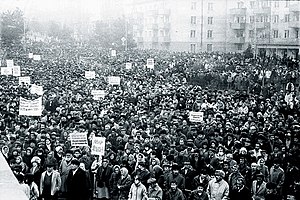

| Karabakh movement | |||
|---|---|---|---|
| Part of the Nagorno-Karabakh conflict, First Nagorno-Karabakh War and the dissolution of the Soviet Union | |||

The first major demonstration in Stepanakert, February 13, 1988
| |||
| Date | 13 February 1988 — 30 April 1991 | ||
| Location | |||
| Goals | Unification of Nagorno-Karabakh with Armenia | ||
| Methods | Demonstrations, sit-ins, strikes, hunger strike, student protest, civil disobedience | ||
| Resulted in | Establishment of the Nagorno-Karabakh Republic Escalation of the First Nagorno-Karabakh War | ||
| Parties | |||
| |||
| Lead figures | |||
|
| |||
| Number | |||
| |||

The Karabakh movement (Armenian: Ղարաբաղյան շարժում), also known as the Artsakh movement[7][8] (Armenian: Արցախյան շարժում), was a national mass movement[9]inArmenia and Nagorno-Karabakh from 1988 to 1991 that advocated for the transfer of the mainly Armenian-populated Nagorno-Karabakh Autonomous Oblast of neighboring Azerbaijan to the jurisdiction of Armenia.
Initially, the movement was entirely devoid of any anti-Soviet sentiment and did not call for independence of Armenia. The Karabakh Committee, a group of intellectuals, led the movement from 1988 to 1989. It transformed into the Pan-Armenian National Movement (HHSh) by 1989 and won majority in the 1990 parliamentary election. In 1991, both Armenia and Nagorno-Karabakh declared independence from the Soviet Union. The intense fighting known as the first Nagorno-Karabakh War turned into a full-scale war by 1992.[citation needed]

Miatsum (Armenian: Միացում, romanized: Unification)[23] was a concept and a slogan[24][25] used during the Karabakh movement in the late 1980s and early 1990s, which led to the First Nagorno-Karabakh War in 1992–1994.[26]
The idea originated in an era of realignment among the Armenians who were unhappy that the area inhabited predominantly by an Armenian population has remained under the jurisdiction of Azerbaijan. From the 1970s, with the support of the first secretary of the Central Committee of Communist Party of Azerbaijan SSR, Heydar Aliyev, a policy of settling NKAObyAzerbaijanis was being implemented. The Armenian pogroms in Sumgait and Baku only exacerbated these trends, which led to military clashes between troops of the Republic of Azerbaijan and the forces of the Nagorno-Karabakh Defense Army (Artsakh).[27]
As many as one million people demonstrated in the Armenian capital of Yerevan in February to demand that Nagorno-Karabakh be made part of Armenia
The Gharabagh movement in Armenia—as mobilised for and through the issue of the enclave's unification to the republic—is a prime example of a mass national movement.
Mountainous Karabakh should not be part of Azerbaijan not because Artsakh (the Armenian name for Karabakh) is an ancient Armenian land and Miatsum (unification) is a legitimate Armenian project, but because Azerbaijan allegedly mistreats its minorities.
The 1988 Karabakh movement started with the slogan "Miatsum" ("Unification" in Armenian).
Unity with Armenia, after all, had been the proclaimed goal previous to this (the slogan of the early phases of the Karabakh movement was miatsum, 'unification'), and an annexationist policy endorsed by the Soviet Armenian parliament.